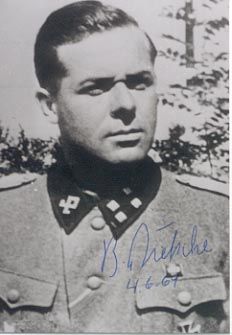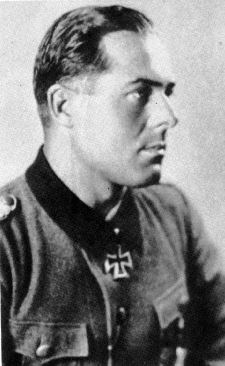Dietsche, Bernhard Anton (Waffen SS)
- Date of birth:
- February 3rd, 1912 (Singen, Germany)
- Date of death:
- January 28th, 1975 (Kaiserslautern/Rhineland-Palatinate, Germany)
- Service number:
- SS-Nr.: 13.578 // NSDAP-Nr.: 760.267 - 5.274.533
- Nationality:
- German (1933-1945, Third Reich)
Biography
00.00.1931: entered the SS
01.12.1931: entered the NSDAP
00.03.1933: Hilfspolizei
18.06.1933: II. Hundertschaft, SS-Verfügungstruppe „Württemberg" in Reutlingen
20.04.1934: promote to SS-Unterscharführer
20.04.1934-00.04.1935: Lehrsturm, SS-Junkerschule Bad Tölz
01.01.1935: SS-Scharführer
01.03.1935: SS-Oberscharführer
17.01.1936: Führeranwärter-Lehrgang, Aufsicht D, SS-Junkerschule Bad Tölz
01.04.1936: SS-Junker
01.06.1936: SS-Standartenjunker
01.02.1937: Zugführerlehrgang, KZ Dachau
20.04.1937: SS-Untersturmführer
21.04.1937: Führer, SS-Junkerschule Bad Tölz
01.05.1937: SS-Ustuf, Zugführer, 12. (MG) Kompanie, SS-Standarte „Germania" 01.02.1938-15.03.1938: Infanterie-Schule Döberitz
01.09.1938: SS-Obersturmführer
17.11.1938: SS-Ostuf, Zugführer, 13. (IG) Kompanie, SS-Standarte "Germania" - campaign in the Sudetes
15.10.1939-15.09.1940: SS-Ostuf, Kompanieführer, 13. (IG) Kompanie, SS-Standarte „Germania" - campaign in Poland
15.09.1940-25.06.1942: SS-Ostuf, Führer, 13. Kompanie, SS-Regiment "Westland"
30.01.1941: SS-Hauptsturmführer
00.06.1941: SS-Hstuf, SS-Panzergrenadier-Regiment 10 „Westland", 5. SS-Division „Wiking"
01.08.1941: WIA to the right arm
01.12.1941: WIA to the left shoulder and the neck
25.06.1942: SS-Hstuf, Bataillonskommandeur, II. Bataillon, SS-Gebirgsjäger-Regiment 2, 7. SS-Division „Prinz Eugen"
30.01.1943: SS-Sturmbannführer
27.03.1944: destruction of the villages Otok, Cornji, Ruda and Dolac Dolnji
29.05.1943: Führer, mot. Vorausabteilung, SS-Freiwilligen-Gebirgs-Division "Prinz Eugen" - Bukovica, Savnik
05.07.1943: WIA to the right arm
01.12.1943: WIA to both hands
01.12.1943-31.12.1943: Führer, SS-Freiwilligen-Gebirgsjäger-Regiment 14
25.01.1944-10.03.1944: Führer, SS-Freiwilligen-Gebirgsjäger-Regiment 14
11.03.1944: Kommandeur, Korps-Eingreifgruppe, V. SS-Gebirgs-Korps / SS-Division „Skanderbeg"
03.05.1944: Taktiklehrer, SS-Junkerschule Bad Tölz
11.07.1944: Taktiklehrer, SS-Junkerschule Braunschweig
01.10.1944: Taktiklehrer and Kommandeur, SS-Junkerschule Bad Tölz
30.01.1945: SS-Obersturmbannführer
00.00.1945: Kdr, 38. SS-Grenadier-Division „Nibelungen"
00.05.1945: US POW
00.07.1947: released
00.06.1948: in captivity in camps Kornwestheim, Hohenasperg, Landau then Ludwigsburg
Do you have more information about this person? Inform us!
- Period:
- Second World War (1939-1945)
- Awarded on:
- 1940
- Period:
- Second World War (1939-1945)
- Rank:
- SS-Obersturmführer (Lieutenant)
- Awarded on:
- 1939
- Period:
- Second World War (1939-1945)
- Rank:
- SS-Hauptsturmführer (Captain)
- Awarded on:
- June 27th, 1941
- Period:
- Second World War (1939-1945)
- Awarded on:
- 1941
- Period:
- Second World War (1939-1945)
- Awarded on:
- 1941
- Period:
- Second World War (1939-1945)
- Rank:
- SS-Hauptsturmführer (Captain)
- Awarded on:
- 1942
- Period:
- Second World War (1939-1945)
- Awarded on:
- 1943
- Period:
- Second World War (1939-1945)
- Awarded on:
- 1943
- Period:
- Second World War (1939-1945)
- Awarded on:
- 1943
- Period:
- Second World War (1939-1945)
- Rank:
- SS-Sturmbannführer (Major)
- Unit:
- Kommandeur, II. Bataillon, SS-Gebirgsjäger-Regiment 2, 7. SS-Freiwilligen-Gebirgs-Division "Prinz Eugen", Heeresgruppe E
- Awarded on:
- July 17th, 1943
“SS-Sturmbannführer Dietsche was dispatched as the commander of the Division’s motorized Vorausabteilung (comprised of the II./SS-Geb.Jg.Rgt. 2, 1 Flak-Zug and the Panzer-Kompanie) from Niksic along the road towards Plevlja with all haste in order to occupy the Bukovica crossings at Savnik. These crossings (3 road bridges) led across a 400 metre deep, trench-like valley. It was essential to prevent them from being blown up by the enemy, as otherwise the Division’s ordered thrust to Zabljak would be irreparably delayed.
Roadblocks hindered the forward advance, and so the Vorausabteilung only advanced into the area south of Savnik at a snail’s pace alongside the Gefechsgruppen Schmidhuber and Petersen (both of which were proceeding towards the north). All of its Kompanien with the exception of 8. Kompanie had to be committed to the developing battle.
On the 29.05.1943 SS-Sturmbannführer Dietsche went forth from the area north of Krusevice in the direction of Mokro with 8. Kompanie and 1 squad of motorcyclists. He could count on support from a heavy mortar and Pak Zug of the Bataillon, as well as the fire of the 10 cm long-barrelled cannons. His goal was to take control of the hills that dominated the winding roads south of Savnik from the southwest. East of him, elements of Kampfgruppe Bachmann (III./SS-Geb.Jg.Rgt. 1) were positioned on Hill 1257 (see sketch A). Thanks to the skillful employment of forces, as well as the fire support of the heavy weapons and artillery, the 8. Kompanie and motorcycle squad from Geb.Jg.Rgt. 2 were able to take control of the Serpentine hills southwest of Savnik relatively quickly.
The Panzer-Kompanie and Flak-Zug could not overcome the roadblock north of Krusevice, as both Pionier-Kompanien from the Division were still working on it. I was present with SS-Sturmbannführer Dietsche at the road block as the 8. Kompanie and motorcyclists were passing through towards Mokro, and once again pointed out the importance of capturing the Savnik crossings via a surprise attack. I knew this brave officer, and was confident that he would master the difficulties.
Now that the hills southwest of Savnik were under friendly control, Dietsche became troubled by further delays in the work to clear the roadblock. Knowing the importance of his mission, he decided not to wait for the Panzer-Kompanie. Instead he decided to proceed alone towards Savnik with the motorcycle squad despite the enemy MG fire from the surrounding hills. He took control of the first two bridges and then dug-in on a hill north of the village that dominated the second bridge, holding out here until the I. Zug from 8. Kompanie reached him 30 minutes later (12:45) after it had advanced from the Cuklin hill.
Coming under fire from heavy MGs and mortars on all sides, Dietsche stood fast with his weak forces until 15:00, when the rest of 8. Kompanie finally linked up with him. The enemy now launched a counterattack, and it was only the personal intervention of this brave officer that ensured that the right wing of the Kompanie did not waver under the enemy pressure in an unfavourable situation. Instead it held out until 16:00, by which time the Panzer-Kompanie arrived. These reinforcements decisively swung the battle in his favour and forced the enemy to retreat (attached sketch A shows the course of this battle).
Thorough preparation, superior leadership and rare bravery characterized this particular operation. And through it all this SS officer achieved a victory that stood head and shoulders above all his previous actions.
A short while afterwards his Bataillon was dispatched via motorized transport from the right wing of the Division to its left wing in the Avtovac area. Here this prudent officer was once again able to complete his mission in a remarkable way.
Deployed eastwards from the Avtovac area, and fighting alongside the friendly forces that were already positioned there, he threw back the enemy forces that had penetrated the lines in the direction of Stabna and Jasen. He then pivoted towards the north in order to fulfill his task of taking over the important Presjeka col (which was 2198 metres in elevation). He threw back the strong enemy forces that were sent against him, captured the Presjeka col and then continued forwards on his own initiative to the Maglic height (2386 metres), which dominated the entire area.
From here he could see every area where the partisan forces were streaming through towards the west, with the goal of forcing a breakthrough over the Sutjeska. He then called on the support of Pak and MG fire, and skillfully directed the fire of the 10 cm long-barrelled cannons that were located on the Cemerno col. All of this fire was rained down on the enemy forces as they advanced through a narrow area. They suffered heavy losses and were forced to delay their movements by hours. By doing all of this Dietsche ensured that significant enemy forces still remained to be destroyed after the pocket west of the Sutjeska was finally closed.
Positioned on this inhospitable massif, where both snow flurries and delays in resupply were endured, Dietsche stood like a rock among his unit and mastered every difficult situation.
The attached sketches B 1-6 show the course of the operation and its final state.
Through these actions he has proven himself worthy of being the first officer of the SS-Freiwilligen-Gebirgs-Division ‘Prinz Eugen’ to be recommended for the noble honour of the Knight’s Cross to the Iron Cross.”
- Period:
- Second World War (1939-1945)
- Awarded on:
- 1944
- Period:
- Second World War (1939-1945)
- Awarded on:
- 1944
Sources
- Photo 1: Willi Schumacher Collection
- Photo 2:
- - THOMAS, FRANZ & WEGMANN, GÜNTER, Die Ritterkreuzträger der Deutschen Wehrmacht 1939-1945.
- Die Ordensträger der Deutschen Wehrmacht (CD), VMD-Verlag GmbH, Osnabrück, 2002
- Fellgiebel W.P., Elite of the Third Reich, The recipients of the Knight's Cross of the Iron Cross 1939-1945: A Reference, Helion & Company Limited, Solihull, 2003, ISBN 1-874622-46-9
- Schneider J.W., Their Honor was Loyalty!, R. James Bender Publishing, 1977


























